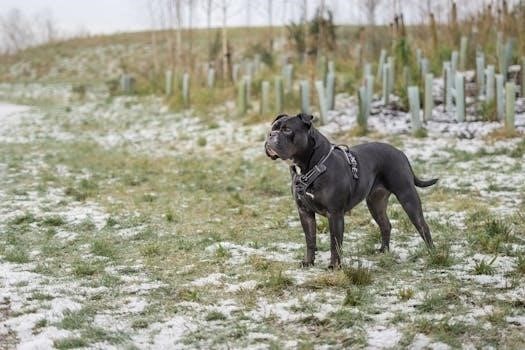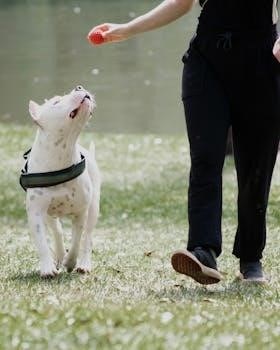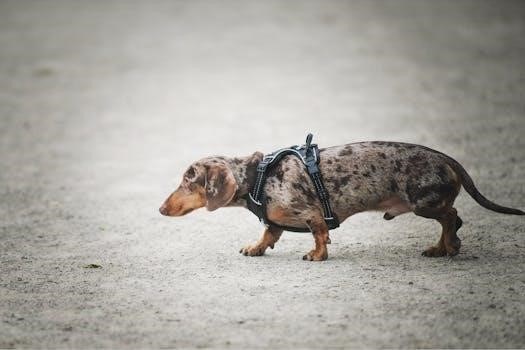Easy Walk Harness Instructions⁚ A Comprehensive Guide
The Easy Walk Harness is designed to gently discourage dogs from pulling while on a leash, making walks more enjoyable. This guide provides comprehensive instructions to ensure a safe and effective experience.
Understanding the Easy Walk Harness
The Easy Walk Harness is a valuable tool designed to help pet owners manage leash pulling, promoting more relaxed and enjoyable walks. Unlike traditional collars that can cause choking or discomfort, this harness gently discourages pulling without putting pressure on the dog’s neck.
Created by a veterinary behaviorist, the Easy Walk Harness addresses pulling by utilizing a front-clip leash attachment. When your dog pulls, the harness redirects their attention towards you, interrupting the pulling motion. The harness features strategically placed straps, including chest, belly, and shoulder straps, ensuring a secure and comfortable fit. Understanding the function of each strap is crucial for proper fitting and use. This humane design allows clear communication and effective training, making walks a positive experience for both you and your furry friend.
Identifying the Harness Straps
Before fitting the Easy Walk Harness, it’s essential to correctly identify each strap, as their proper placement is vital for the harness’s effectiveness and your dog’s comfort; The harness features three primary straps⁚ the chest strap, the belly strap, and the shoulder straps.
The chest strap is located at the front of the harness and typically features a martingale loop or D-ring where the leash will be attached. The belly strap encircles your dog’s torso behind their front legs, securing the harness around their body. Finally, the shoulder straps go over your dog’s shoulders, connecting the chest strap to the belly strap. These straps are adjustable to ensure a snug and comfortable fit. Recognizing each strap will simplify the fitting process, contributing to a successful and stress-free experience for both you and your canine companion.

Fitting the Easy Walk Harness
Properly fitting the Easy Walk Harness is essential for your dog’s comfort and safety. Follow these step-by-step instructions to achieve a snug and secure fit.
Step 1⁚ Placing the Harness Over the Head
Begin by holding the Easy Walk Harness with the chest strap and Martingale loop facing forward. Gently slip the shoulder strap over your dog’s head, ensuring it sits comfortably around their neck. The connector rings should be positioned above and behind your dog’s shoulders.
Take care not to force the harness over your dog’s head. If your dog seems tense, offer praise and treats to help them relax. Ensure the harness is not twisted and that the straps are laying flat against your dog’s fur. Double-check that the Martingale loop is in the front, ready for leash attachment.
This initial step is crucial for ensuring the harness is correctly positioned before securing the remaining straps. A proper fit around the neck will prevent discomfort and ensure the effectiveness of the harness in discouraging pulling.
Step 2⁚ Securing the Belly Strap
Once the shoulder strap is in place, reach down and bring the belly strap up and around your dog’s torso, behind their front legs. Snap the belly strap into the buckle located on the opposite side of the harness. Listen for a click to ensure it is securely fastened.
Make sure the belly strap is snug but not too tight. You should be able to fit two fingers comfortably between the strap and your dog’s body. Avoid overtightening the strap, as this can cause discomfort or restrict movement. If the strap is too loose, the harness may slip or rotate.
Observe your dog’s reaction as you secure the belly strap. If they appear uncomfortable, loosen the strap slightly. Positive reinforcement, such as praise and treats, can help create a positive association with the harness. Ensure the belly strap sits fairly straight up and down.
Step 3⁚ Adjusting the Shoulder Straps
After securing the belly strap, it’s time to adjust the shoulder straps for a snug and comfortable fit. The connector rings should sit above and slightly behind your dog’s shoulders. Adjust the straps by sliding the adjusters up or down as needed.
Ensure the straps are evenly adjusted on both sides to maintain proper balance and prevent the harness from shifting. The goal is to achieve a snug fit without restricting your dog’s natural range of motion. Check for any signs of rubbing or irritation, particularly around the armpits.
If the connector rings are positioned too low, the harness may not function correctly and could cause discomfort. Conversely, if they are too high, the harness may ride up and interfere with your dog’s neck. Fine-tune the shoulder straps until the connector rings are in the ideal position.
Step 4⁚ Adjusting the Chest Strap
The chest strap is crucial for preventing pulling and ensuring the harness functions effectively. Locate the chest strap, which contains the Martingale loop where the leash will be attached. Adjust this strap to achieve a snug but comfortable fit across your dog’s chest.
The chest strap should be positioned high enough on the chest to discourage pulling without causing discomfort or restricting movement. Tighten or loosen the strap as needed, ensuring there is enough room to comfortably slide two fingers between the strap and your dog’s chest.
Avoid overtightening the chest strap, as this can cause chafing or restrict breathing. Conversely, a loose chest strap will render the harness ineffective in preventing pulling. Regularly check the adjustment of the chest strap and readjust as needed to maintain a proper and comfortable fit for your dog.

Ensuring a Proper and Comfortable Fit
A well-fitted Easy Walk Harness is key for your dog’s comfort and the harness’s effectiveness. Regularly check the fit and make adjustments to ensure safety and prevent chafing.
Checking the Connector Rings Position
The position of the connector rings is critical for the correct functioning and comfort of the Easy Walk Harness. These rings should be located above and slightly behind your dog’s shoulders, ensuring they do not restrict movement or cause discomfort. If the rings are too far forward, the harness may not effectively discourage pulling. If they are too far back, they could rub and irritate your dog’s skin.
To verify the correct placement, observe your dog’s gait while walking. The rings should remain stable and not shift excessively. Make adjustments to the shoulder straps as needed to achieve the optimal position. Proper placement ensures the harness applies gentle pressure to discourage pulling without causing pain or hindering your dog’s natural movement. Consistently monitor the ring position during walks, especially when the harness is new, as adjustments may be necessary.
Verifying the Belly Strap Alignment
Proper belly strap alignment is essential for a comfortable and secure fit of the Easy Walk Harness. The belly strap should run straight up and down along your dog’s body, positioned behind their front legs and in front of their rear legs. Ensure the strap is not twisted or angled, as this can cause chafing and discomfort. A misaligned belly strap can also affect the harness’s ability to discourage pulling effectively.
To check the alignment, observe your dog from the side. The strap should form a vertical line. Adjust the shoulder straps if the belly strap is angled forward or backward. The strap should fit snugly but not tightly, allowing you to slide two fingers between the strap and your dog’s body. Regularly check the alignment, especially after initial use and during longer walks, to maintain comfort and prevent irritation.
Monitoring for Tension and Adjusting Accordingly
Closely monitoring the tension of the Easy Walk Harness straps is crucial for your dog’s comfort and the harness’s effectiveness. While walking, observe how the harness fits when your dog pulls or strains against the leash. If you notice the harness shifting excessively or causing your dog discomfort, adjustments are necessary. Excessive tension can lead to chafing or restrict movement, while insufficient tension renders the harness ineffective.
Periodically check the fit by sliding your fingers under each strap. You should be able to fit two fingers comfortably. If the straps feel too tight, loosen them. If they feel too loose, tighten them slightly. Pay particular attention to the chest and belly straps, as these are most prone to shifting during walks. Consistent monitoring and adjustment will ensure a secure, comfortable, and effective fit, promoting positive leash manners.

Training and Leash Attachment
Proper leash attachment and training are essential for maximizing the Easy Walk Harness benefits. This section covers how to correctly attach the leash and effective training techniques to minimize pulling.
Attaching the Leash to the Martingale Loop
The Easy Walk Harness features a Martingale loop located on the chest strap, which is crucial for effective no-pull training. To properly attach the leash, first, identify the Martingale loop—it’s the metal ring on the front of the harness. Next, take the leash clip and securely fasten it to this loop.
When your dog pulls, the Martingale loop gently tightens, discouraging them without causing discomfort or choking. This front attachment redirects your dog’s attention back to you, promoting better leash manners. Ensure the clip is securely attached before starting your walk.
This connection allows for clear communication, helping your dog understand the desired pace and direction. Remember to use positive reinforcement along with the harness for optimal results.
Training Techniques to Minimize Pulling
To effectively use the Easy Walk Harness, combine it with consistent training techniques. When your dog starts to pull, gently stop walking. This signals to your dog that pulling will not result in forward movement. Wait until your dog relaxes and the leash loosens before continuing.
Use positive reinforcement, such as praise or treats, when your dog walks nicely by your side. Keep training sessions short and frequent, focusing on rewarding desired behaviors. Change direction frequently to keep your dog engaged and attentive to you.
Avoid jerking or yanking the leash, as this can be counterproductive and uncomfortable for your dog. Consistency is key; ensure everyone who walks your dog uses the same techniques. Over time, your dog will learn that walking calmly results in a more pleasant experience.

Safety and Maintenance
Regularly inspect the harness for wear and tear to ensure its integrity. Proper maintenance and careful attention to safety will help extend the harness’s life and protect your dog.
Regularly Inspecting the Harness for Wear and Tear
To ensure your dog’s safety and the harness’s effectiveness, conduct routine inspections before each use. Check all straps for fraying, tears, or weakening. Pay close attention to the stitching and any areas that experience friction. Examine the plastic buckles and metal rings for damage or corrosion. Ensure the martingale loop moves freely and is not bent or distorted.
Replace the harness immediately if you notice any signs of significant wear. A compromised harness may fail during a walk, potentially leading to your dog escaping or getting injured. Regular inspections will help you identify issues early, preventing accidents and ensuring the harness continues to function as intended. Proper care and maintenance are essential for prolonging the life of the harness and safeguarding your dog’s well-being.
